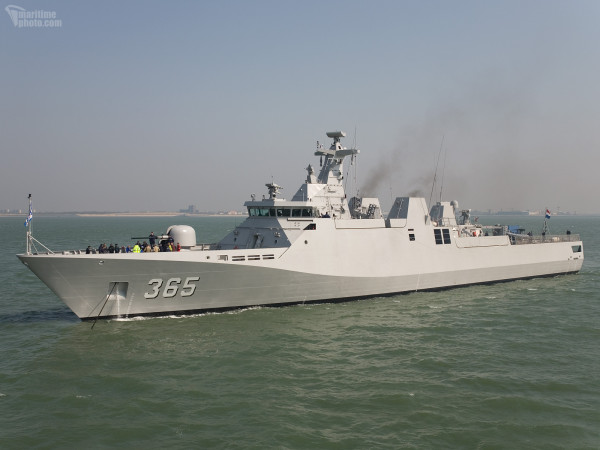The worsening dispute in the South China Sea has raised concerns about the inadvertent outbreak of conflict in the face of the increased militarization. With China’s modernizing and developing its naval capabilities at a remarkable pace, the other littoral states of the South China Sea have been investing in their naval capabilities in order to stay in the game. While Indonesia is not a claimant to the disputes in the South China Sea, the country has been concerned about growing regional instability. It has been working on reinvigorating its ageing navy through new construction.
Indonesia is the largest country in South East Asia in terms of gross domestic product, population and area. Despite these favourable metrics, it does not have the region’s most capable military. In naval terms, the picture is even less promising with neighbouring (and much smaller) Singapore and Malaysia possessing more capable naval forces. In 2010, to remedy this situation and broader issues with the military, Indonesia began a military modernisation program with the aim of attaining a ‘Minimum Essential Force’ (MEF) by 2024. Among other things, the main objective of the Indonesian National Armed Forces was to create a modern navy with 247 surface vessels and 12 submarines.
An Indonesian Sigma-class corvette[/caption]On paper, the combat branch of the Indonesian Navy is quite large. It has six Dutch-built Ahmed Yani/Van Speijk-class light frigates, 10 corvettes of three classes, and 16 East German origin Kapitan Patimura/Parchim-class light corvettes. While such figures appear impressive, the six Van Speikj-class light frigates are all 47-48 years old and require immediate replacement. With only two new and quite capable Dutch-built Sigma-class light frigates on order, the remaining Van Speijk-class frigates will have to be retired or laid up without replacement unless Indonesia purchases or builds more warships. Its 10 corvettes are composed of four new and quite capable Dutch-built Sigma-class corvettes, three lightly armed but new British-built patrol corvettes and three ageing patrol corvettes. The latter will soon turn 40 years old and require replacement. The 16 ex-East German light Parchim-class corvettes are obsolete for any task other than patrolling. Worse still, they are all between 30 and 34 years old and also require replacement soon. The rest of the Indonesian Navy’s surface combat capabilities is provided by a few dozen very small and lightly-armed patrol vessels and some missile boats. In the coming years, the Indonesian Navy plans to construct 24 new missile boats.
On paper, the Indonesian Navy appears sizable, impressive and capable. Yet for an archipelagic country of the size of Indonesia, just over thirty warships does not provide much in terms of dispersed capability. Moreover, only seven of the thirty-two warships in inventory are less than 34 years old and the Indonesian Navy will require substantial funds to replace its existing fleet, let alone undergo expansion. Given the scarcity of funds and the high cost of new warships, Indonesia is unlikely sustain the current size of its surface fleet if it replaced all its aging vessels at the same time. As such, it is likely that the oldest vessels will be replaced first while those relative younger (at an old age of over 30 years) will be retained in the near term. An additional problem compounding the navy is that its diverse fleet is home to an even more diverse inventory of guns, missiles and electronic systems. While this aspect of inventory management can be expected to improve in coming years as older ship classes (some ship classes underwent different upgrades within the class) are retired, that depends on the Indonesian Navy’s prioritizing standardization and interoperability. At the same time, the continued service of older vessels poses significant interoperability challenges for the ship crews given that the age gap between the newer and older classes is measured in decades.
While surface ships are inherently multi-purposed, submarines can only be used for offensive operations or, in more theoretical terms, for sea denial. Sea denial refers to a mission set that seeks to prevent an adversary from utilising the seas for its own purposes. Because submarines are underwater and hard to detect, they make for excellent sea denial platforms. Indonesia had an important learning experience with submarines, having used them to shadow international forces intervening in Timor Leste (East Timor) in 1999. Indonesia currently has two German-built submarines of the Cakra/Type 209-1300-class. Commissioned in 1981, these submarines are now 34 years old and require replacement soon. Even so, Indonesia has upgraded these two aged vessels in recent years, suggesting that it will try squeeze a few more years out of them. That said, should these vessels still be in service by 2020, they will be almost 39 years old and likely increasingly unsafe for use. To ameliorate this situation, Indonesia has purchased three South Korea built derivatives of the German Type 209-class, the Chango-bo class. These submarines are likely to replace, not supplement the two existing Cakra-class submarines. Unless new submarines are ordered very soon, Indonesia is unlikely to have more than three submarines in service by the early 2020s (assuming that the two old submarines will remain in service).
Indonesia is making efforts to modernize its old and diverse fleet of warships. At present, the fleet is generally regarded to be insufficient to provide coverage of the country’s archipelagic waters, let alone more distant areas such as the Nantuna Islands in the disputed South China Sea. Despite progress being made, significant challenges abound, not least in terms of inadequate new construction to replace obsolete and ancient warships. In short, despite being the largest, richest and most populous country in South East Asia, Indonesia’s naval capabilities need a lot of improving before it can pull its commensurate weight in an increasingly tense Indo-Pacific region.




